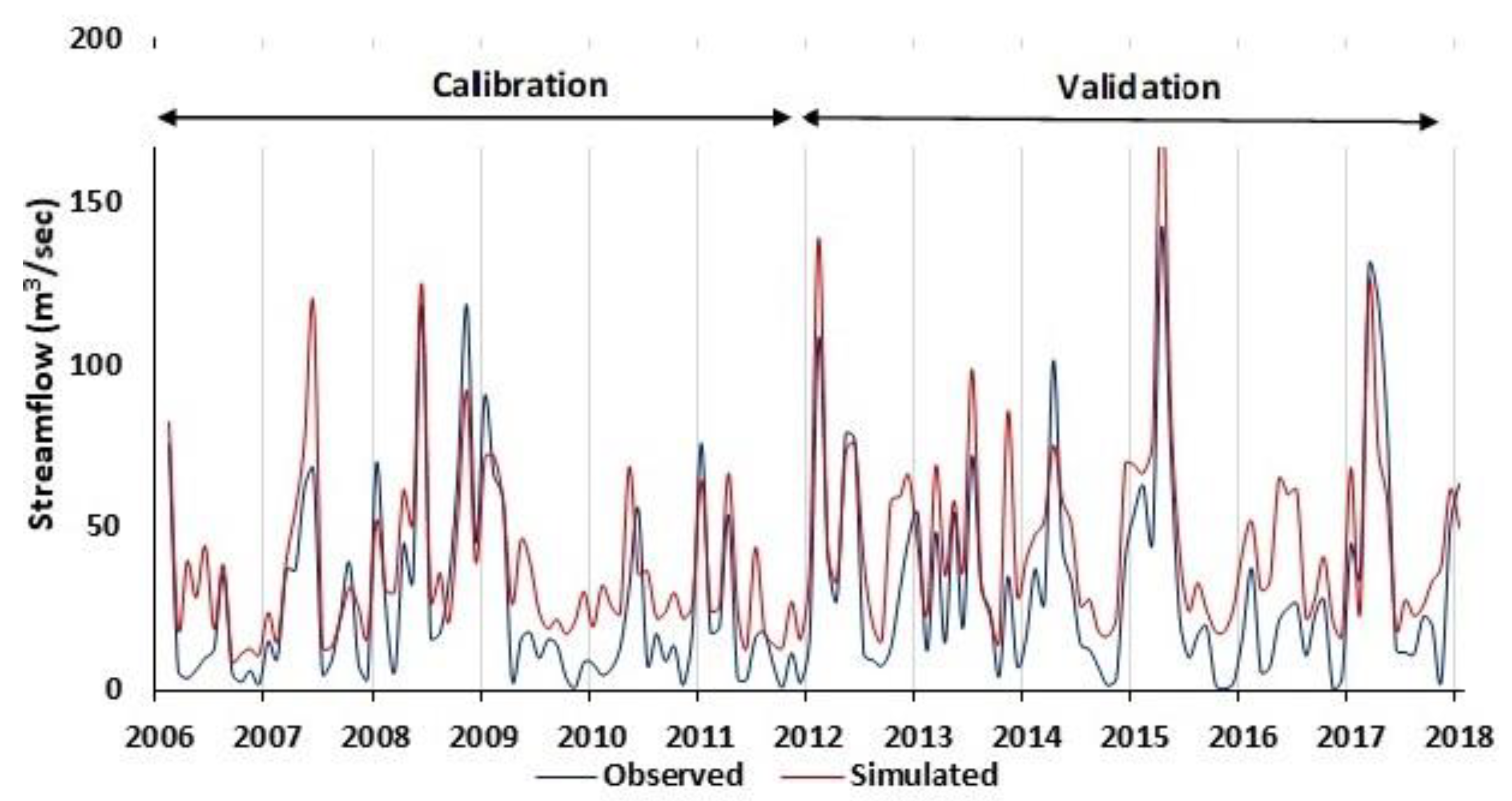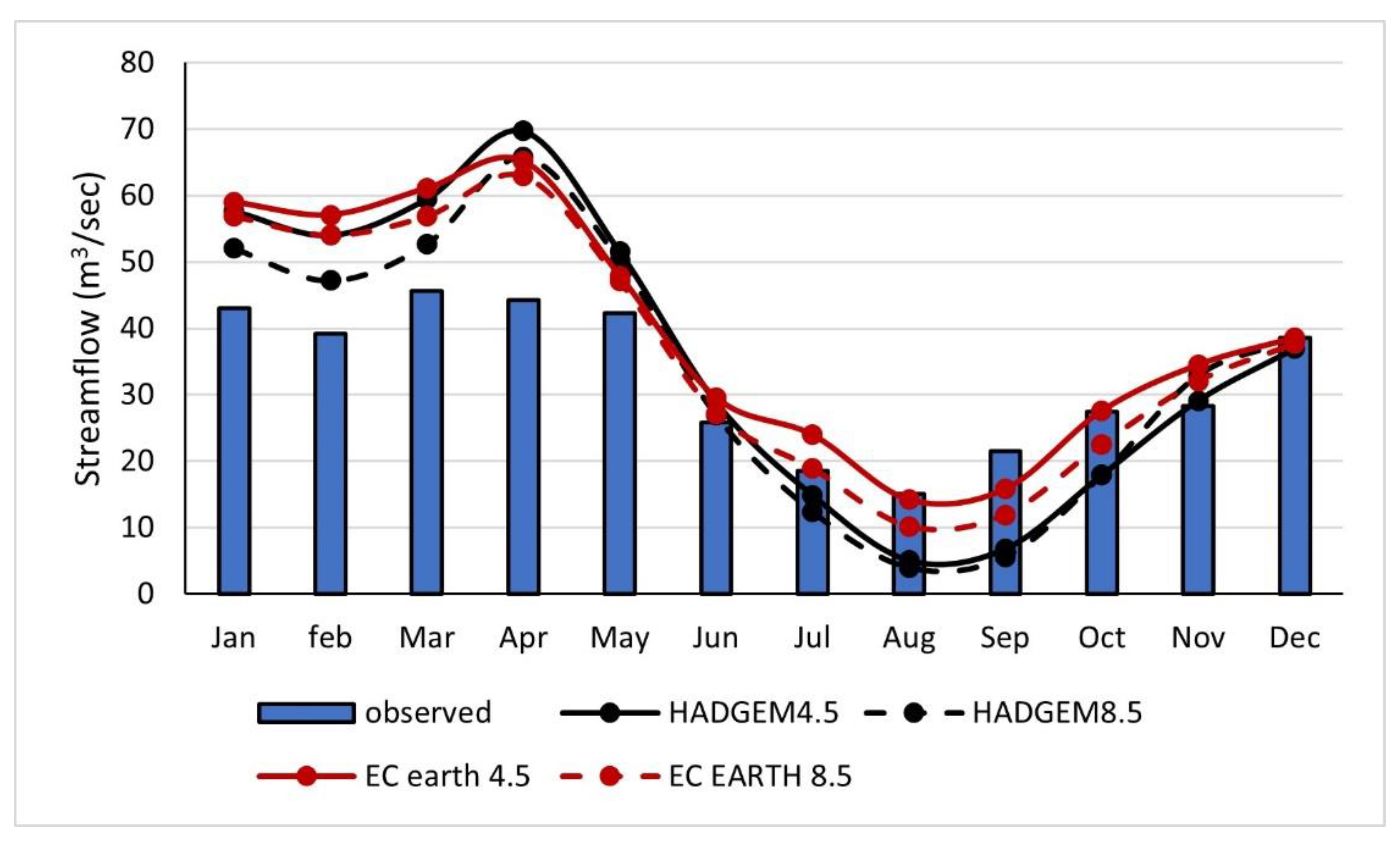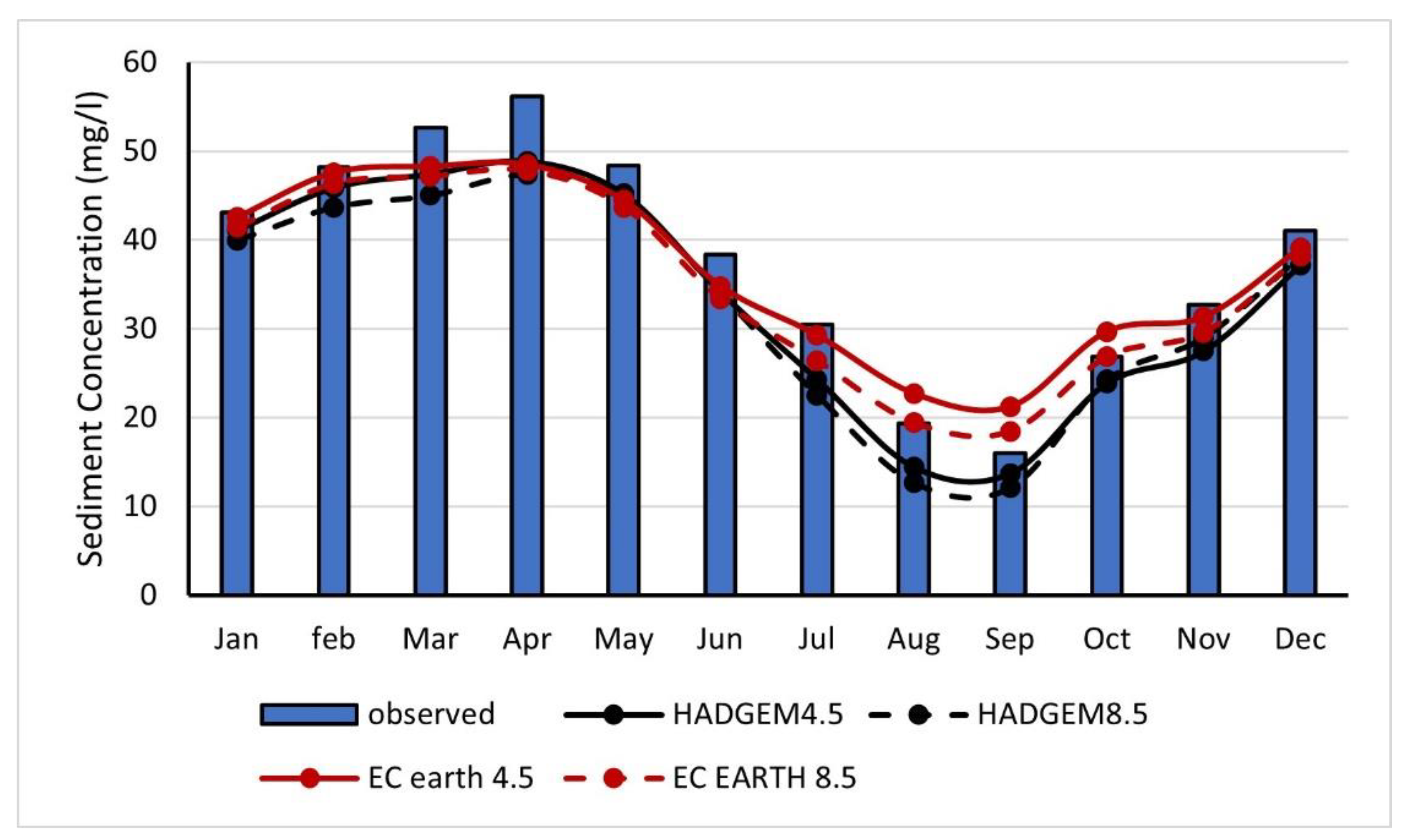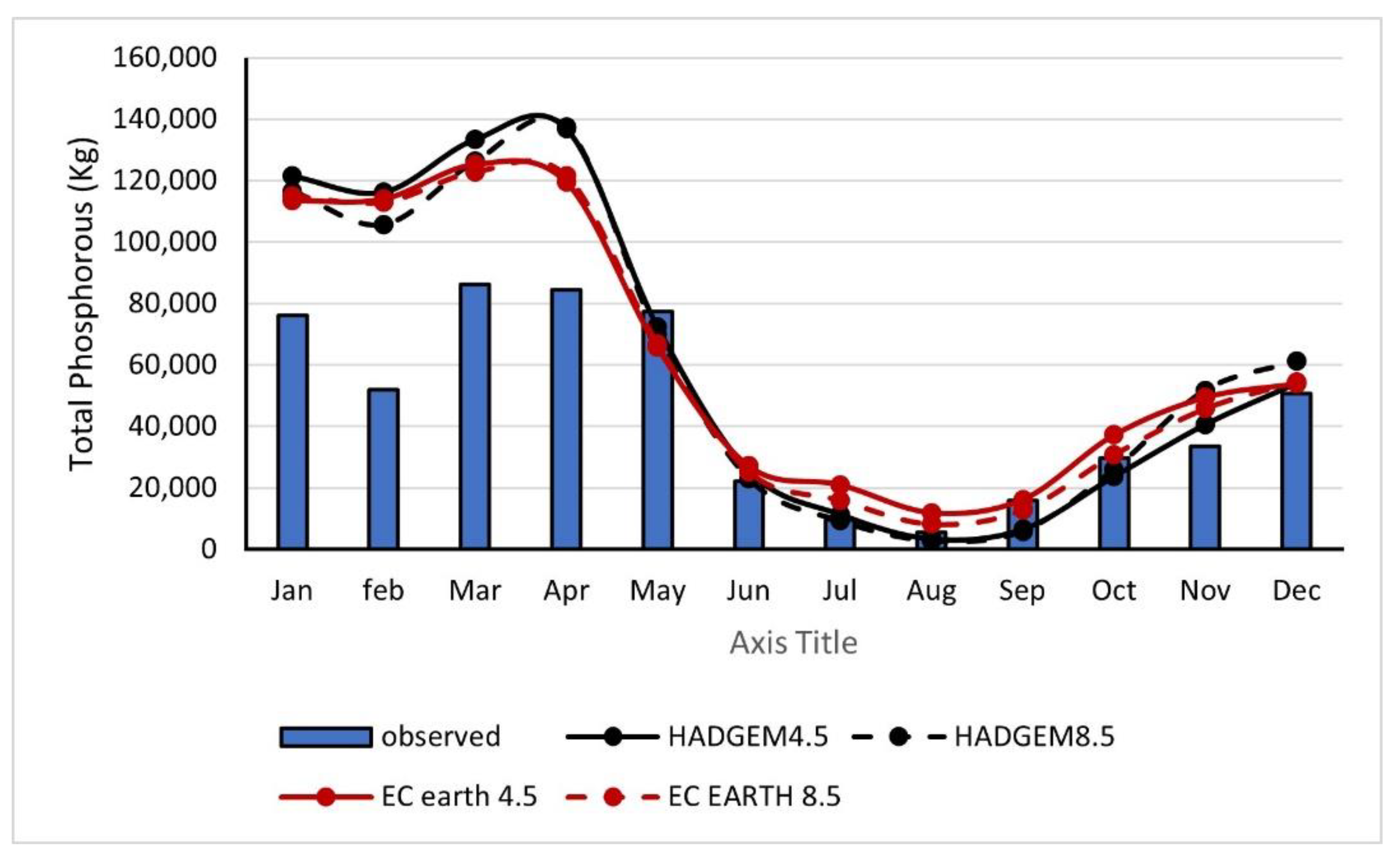Evaluation of Climate Change on Streamflow, Sediment, and Nutrient Load at Watershed Scale
Abstract
:1. Introduction
2. Methods and Methodology
2.1. Study Area
2.2. Data
2.3. LARS-WG
2.4. SWAT
3. Result and Discussion
3.1. SWAT Model Recalibration and Revalidation
3.2. Climate Change Analysis
3.3. Climate Change Impact on Hydrology and Water Quality
3.3.1. Climate Change Impact on Streamflow
3.3.2. Climate Change Impact on Sediment Concentration
3.3.3. Climate Change Impact on TN Load
3.3.4. Climate Change Impact on Monthly TP Load
4. Conclusions
Author Contributions
Funding
Data Availability Statement
Acknowledgments
Conflicts of Interest
References
- IPCC. Global Warming of 1.5 °C an IPCC Special Report on the Impacts of Global Warming of 1.5 °C above Pre-Industrial Levels and Related Global Greenhouse Gas Emission Pathways, in the Context of Strengthening the Global Response to the Threat of Climate Change, Sustainable Development, and Efforts to Eradicate Poverty; IPCC: Geneva, Switzerland, 2018. [Google Scholar]
- Robinson, S. Climate change adaptation in SIDS: A systematic review of the literature pre and post the IPCC Fifth Assessment Report. Wiley Interdiscip. Rev. Clim. Chang. 2020, 11, e653. [Google Scholar] [CrossRef]
- Lindner, M.; Maroschek, M.; Netherer, S.; Kremer, A.; Barbati, A.; Garcia-Gonzalo, J.; Seidl, R.; Delzon, S.; Corona, P.; Kolström, M. Climate change impacts, adaptive capacity, and vulnerability of European forest ecosystems. For. Ecol. Manag. 2010, 259, 698–709. [Google Scholar] [CrossRef]
- Li, Z.; Liu, W.-Z.; Zhang, X.-C.; Zheng, F.-L. Assessing the site-specific impacts of climate change on hydrology, soil erosion and crop yields in the Loess Plateau of China. Clim. Chang. 2011, 105, 223–242. [Google Scholar] [CrossRef]
- Semenov, M.A.; Brooks, R.J.; Barrow, E.M.; Richardson, C.W. Comparison of the WGEN and LARS-WG stochastic weather generators for diverse climates. Clim. Res. 1998, 10, 95–107. [Google Scholar] [CrossRef] [Green Version]
- Dakhlalla, A.O.; Parajuli, P.B. Sensitivity of Fecal Coliform Bacteria Transport to Climate Change in an Agricultural Watershed. J. Water Clim. Chang. 2020, 11, 1250–1262. [Google Scholar] [CrossRef]
- Chen, Y.; Marek, G.W.; Marek, T.H.; Moorhead, J.E.; Heflin, K.R.; Brauer, D.K.; Gowda, P.H.; Srinivasan, R. Simulating the impacts of climate change on hydrology and crop production in the Northern High Plains of Texas using an improved SWAT model. Agric. Water Manag. 2019, 221, 13–24. [Google Scholar] [CrossRef]
- Ouyang, Y.; Parajuli, P.B.; Feng, G.; Leininger, T.D.; Wan, Y.; Dash, P. Application of Climate Assessment Tool (CAT) to Estimate Climate Change Impacts on Water Quality for Local Watersheds. J. Hydrol. 2018, 563, 363–371. [Google Scholar] [CrossRef]
- Aawar, T.; Khare, D. Assessment of climate change impacts on streamflow through hydrological model using SWAT model: A case study of Afghanistan. Model. Earth Syst. Environ. 2020, 6, 1427–1437. [Google Scholar] [CrossRef]
- Bhatta, B.; Shrestha, S.; Shrestha, P.K.; Talchabhadel, R. Evaluation and application of a SWAT model to assess the climate change impact on the hydrology of the Himalayan River Basin. Catena 2019, 181, 104082. [Google Scholar] [CrossRef]
- Yu, Z.; Man, X.; Duan, L.; Cai, T. Assessments of Impacts of Climate and Forest Change on Water Resources Using SWAT Model in a Subboreal Watershed in Northern Da Hinggan Mountains. Water 2020, 12, 1565. [Google Scholar] [CrossRef]
- Taylor, K.E.; Stouffer, R.J.; Meehl, G.A. An overview of CMIP5 and the experiment design. Bull. Am. Meteorol. Soc. 2012, 93, 485–498. [Google Scholar] [CrossRef] [Green Version]
- Bekele, D.; Alamirew, T.; Kebede, A.; Zeleke, G.; Melesse, A.M. Modeling climate change impact on the Hydrology of Keleta watershed in the Awash River basin, Ethiopia. Environ. Modeling Assess. 2019, 24, 95–107. [Google Scholar] [CrossRef]
- Buras, A.; Menzel, A. Projecting tree species composition changes of European forests for 2061–2090 under RCP 4.5 and RCP 8.5 scenarios. Front. Plant Sci. 2019, 9, 1986. [Google Scholar] [CrossRef] [Green Version]
- Koo, K.A.; Kong, W.-S.; Nibbelink, N.P.; Hopkinson, C.S.; Lee, J.H. Potential effects of climate change on the distribution of cold-tolerant evergreen broadleaved woody plants in the Korean Peninsula. PLoS ONE 2015, 10, e0134043. [Google Scholar]
- Nilawar, A.P.; Waikar, M.L. Impacts of climate change on streamflow and sediment concentration under RCP 4.5 and 8.5: A case study in Purna river basin, India. Sci. Total. Environ. 2019, 650, 2685–2696. [Google Scholar] [CrossRef] [PubMed]
- Semenov, M.A.; Barrow, E.M. Use of a stochastic weather generator in the development of climate change scenarios. Clim. Chang. 1997, 35, 397–414. [Google Scholar] [CrossRef]
- Kim, H.K.; Parajuli, P.B.; Filip To, S.D. Assessing impacts of bioenergy crops and climate change on hydrometeorology in the Yazoo River Basin, Mississippi. Agric. For. Meteorol. 2013, 169, 61–73. [Google Scholar] [CrossRef]
- Semenov, M.A.; Stratonovitch, P. Use of multi-model ensembles from global climate models for assessment of climate change impacts. Clim. Res. 2010, 41, 1–14. [Google Scholar] [CrossRef] [Green Version]
- Parajuli, P.B.; Jayakody, P.; Sassenrath, G.F.; Ouyang, Y. Assessing the impacts of climate change and tillage practices on stream flow, crop and sediment yields from the Mississippi River Basin. Agric. Water Manag. 2016, 168, 112–124. [Google Scholar] [CrossRef] [Green Version]
- Parajuli, P.B.; Jayakody, P.; Sassenrath, G.F.; Ouyang, Y.; Pote, J.W. Assessing the impacts of crop-rotation and tillage on crop yields and sediment yield using a modeling approach. Agric. Water Manag. 2013, 119, 32–42. [Google Scholar] [CrossRef]
- Arnold, J.G.; Srinivasan, R.; Muttiah, R.S.; Williams, J.R. Large area hydrologic modeling and assessment part I: Model development 1. J. Am. Water Resour. Assoc. 1998, 34, 73–89. [Google Scholar] [CrossRef]
- Gassman, P.W.; Reyes, M.R.; Green, C.H.; Arnold, J.G. The soil and water assessment tool: Historical development, applications, and future research directions. Trans. ASABE 2007, 50, 1211–1250. [Google Scholar] [CrossRef] [Green Version]
- Neitsch, S.L.; Arnold, J.G.; Kiniry, J.R.; Williams, J.R.; King, K.W. Soil and Water Assessment Tool Theoretical Documentation, Version 2005; USDA-ARS Grassland; Soil Water Research Laboratory: Temple, TX, USA, 2005; p. 8. [Google Scholar]
- Licciardello, F.; Toscano, A.; Cirelli, G.L.; Consoli, S.; Barbagallo, S. Evaluation of sediment deposition in a Mediterranean reservoir: Comparison of long term bathymetric measurements and SWAT estimations. Land Degrad. Dev. 2017, 28, 566–578. [Google Scholar] [CrossRef]
- Tan, M.L.; Gassman, P.W.; Cracknell, A.P. Assessment of three long-term gridded climate products for hydro-climatic simulations in tropical river basins. Water 2017, 9, 229. [Google Scholar] [CrossRef] [Green Version]
- Risal, A.; Parajuli, P.B.; Dash, P.; Ouyang, Y.; Linhoss, A. Sensitivity of hydrology and water quality to variation in land use and land cover data. Agric. Water Manag. 2020, 241, 106366. [Google Scholar] [CrossRef]
- Zhang, Y.; You, Q.; Chen, C.; Ge, J. Impacts of climate change on streamflows under RCP scenarios: A case study in Xin River Basin, China. Atmos. Res. 2016, 178–179, 521–534. [Google Scholar] [CrossRef]
- Azim, F.; Shakir, A.S.; ur-Rehman, H.; Kanwal, A. Impact of climate change on sediment yield for Naran watershed, Pakistan. Int. J. Sediment Res. 2016, 31, 212–219. [Google Scholar] [CrossRef]
- Naik, P.K.; Jay, D.A. Distinguishing human and climate influences on the Columbia River: Changes in mean flow and sediment transport. J. Hydrol. 2011, 404, 259–277. [Google Scholar] [CrossRef]
- Zabaleta, A.; Martínez, M.; Uriarte, J.A.; Antigüedad, I. Factors controlling suspended sediment yield during runoff events in small headwater catchments of the Basque Country. CATENA 2007, 71, 179–190. [Google Scholar] [CrossRef]
- Olesen, J.E.; Carter, T.R.; Diaz-Ambrona, C.H.; Fronzek, S.; Heidmann, T.; Hickler, T.; Holt, T.; Minguez, M.I.; Morales, P.; Palutikof, J.P. Uncertainties in projected impacts of climate change on European agriculture and terrestrial ecosystems based on scenarios from regional climate models. Clim. Chang. 2007, 81, 123–143. [Google Scholar] [CrossRef]
- Olesen, J.E.; Jensen, T.; Petersen, J. Sensitivity of field-scale winter wheat production in Denmark to climate variability and climate change. Clim. Res. 2000, 15, 221–238. [Google Scholar] [CrossRef]
- Chaubey, I.; Migliaccio, K.W.; Green, C.H.; Arnold, J.G.; Srinivasan, R. Phosphorus modeling in soil and water assessment tool (SWAT) model. Model. Phosphorus Environ. 2006, 163–187. [Google Scholar] [CrossRef]
- Zhang, J.; Gao, G.; Fu, B.; Gupta, H.V. Formulating an elasticity approach to quantify the effects of climate variability and ecological restoration on sediment discharge change in the Loess Plateau, China. Water Resour. Res. 2019, 55, 9604–9622. [Google Scholar] [CrossRef]









| Streamflow | Sediment yield | TN | TP | |||||||||||||
|---|---|---|---|---|---|---|---|---|---|---|---|---|---|---|---|---|
| Calibration | Validation | Calibration | Validation | Calibration | Validation | Calibration | Validation | |||||||||
| R2 | NSE | R2 | NSE | R2 | NSE | R2 | NSE | R2 | NSE | R2 | NSE | R2 | NSE | R2 | NSE | |
| Marigold | 0.68 | 0.54 | 0.66 | 0.56 | 0.75 | 0.48 | 0.59 | 0.30 | 0.59 | 0.32 | 0.45 | 0.20 | 0.85 | 0.77 | 0.67 | 0.65 |
| Sunflower | 0.75 | 0.79 | 0.75 | 0.79 | 0.67 | 0.42 | 0.72 | 0.31 | 0.78 | 0.31 | 0.33 | 0.19 | 0.91 | 0.51 | 0.80 | 0.75 |
| Leland | 0.75 | 0.79 | 0.88 | 0.87 | 0.59 | 0.39 | 0.66 | 0.32 | 0.80 | 0.69 | 0.48 | 0.23 | 0.81 | 0.49 | 0.67 | 0.56 |
| Parameter | Model | Scenario | 2021–2040 | 2041–2060 | 2061–2080 |
|---|---|---|---|---|---|
| Minimum Temperature | HadGEM2 | RCP 4.5 | 12.7 | 13.9 | 14.6 |
| RCP 8.5 | 13.0 | 14.5 | 15.9 | ||
| EC Earth | RCP 4.5 | 12.4 | 12.8 | 13.2 | |
| RCP 8.5 | 12.5 | 13.2 | 14.1 | ||
| Maximum Temperature | HadGEM2 | RCP 4.5 | 24.8 | 26.2 | 26.4 |
| RCP 8.5 | 25.1 | 27.1 | 28.3 | ||
| EC Earth | RCP 4.5 | 24.3 | 24.7 | 25.1 | |
| RCP 8.5 | 24.4 | 25.1 | 26.0 | ||
| Precipitation | HadGEM2 | RCP 4.5 | 3.9 | 3.9 | 4.3 |
| RCP 8.5 | 4.0 | 3.6 | 3.8 | ||
| EC Earth | RCP 4.5 | 4.0 | 4.1 | 4.2 | |
| RCP 8.5 | 3.8 | 4.1 | 4.0 |
| Model | Scenario | 2021–2040 | 2041–2060 | 2061–2080 |
|---|---|---|---|---|
| HadGEM2 | RCP 4.5 | 5 | 0 | 17 |
| RCP 8.5 | 15 | −19 | 13 | |
| EC_Earth | RCP 4.5 | 19 | 2 | 3 |
| RCP 8.5 | 5 | 13 | −3 |
| Model | Scenario | 2021–2040 | 2041–2060 | 2061–2080 |
|---|---|---|---|---|
| HadGEM2 | RCP 4.5 | −12 | −2 | 7 |
| RCP 8.5 | −6 | −14 | 7 | |
| EC_Earth | RCP 4.5 | −3 | −1 | 2 |
| RCP 8.5 | −10 | 4 | −1 |
| Model | Scenario | 2021–2040 | 2041–2060 | 2061–2080 |
|---|---|---|---|---|
| HadGEM2 | RCP 4.5 | 14 | −1 | 10 |
| RCP 8.5 | 38 | −17 | 7 | |
| EC_Earth | RCP 4.5 | 37 | −11 | −1 |
| RCP 8.5 | 9 | 10 | −8 |
| Model | Scenario | 2021–2040 | 2041–2060 | 2061–2080 |
|---|---|---|---|---|
| HadGEM2 | RCP 4.5 | 30 | 3 | 11 |
| RCP 8.5 | 37 | −5 | 8 | |
| EC_Earth | RCP 4.5 | 37 | 2 | 1 |
| RCP 8.5 | 28 | 9 | −1 |
Publisher’s Note: MDPI stays neutral with regard to jurisdictional claims in published maps and institutional affiliations. |
© 2021 by the authors. Licensee MDPI, Basel, Switzerland. This article is an open access article distributed under the terms and conditions of the Creative Commons Attribution (CC BY) license (https://creativecommons.org/licenses/by/4.0/).
Share and Cite
Parajuli, P.B.; Risal, A. Evaluation of Climate Change on Streamflow, Sediment, and Nutrient Load at Watershed Scale. Climate 2021, 9, 165. https://doi.org/10.3390/cli9110165
Parajuli PB, Risal A. Evaluation of Climate Change on Streamflow, Sediment, and Nutrient Load at Watershed Scale. Climate. 2021; 9(11):165. https://doi.org/10.3390/cli9110165
Chicago/Turabian StyleParajuli, Prem B., and Avay Risal. 2021. "Evaluation of Climate Change on Streamflow, Sediment, and Nutrient Load at Watershed Scale" Climate 9, no. 11: 165. https://doi.org/10.3390/cli9110165
APA StyleParajuli, P. B., & Risal, A. (2021). Evaluation of Climate Change on Streamflow, Sediment, and Nutrient Load at Watershed Scale. Climate, 9(11), 165. https://doi.org/10.3390/cli9110165







